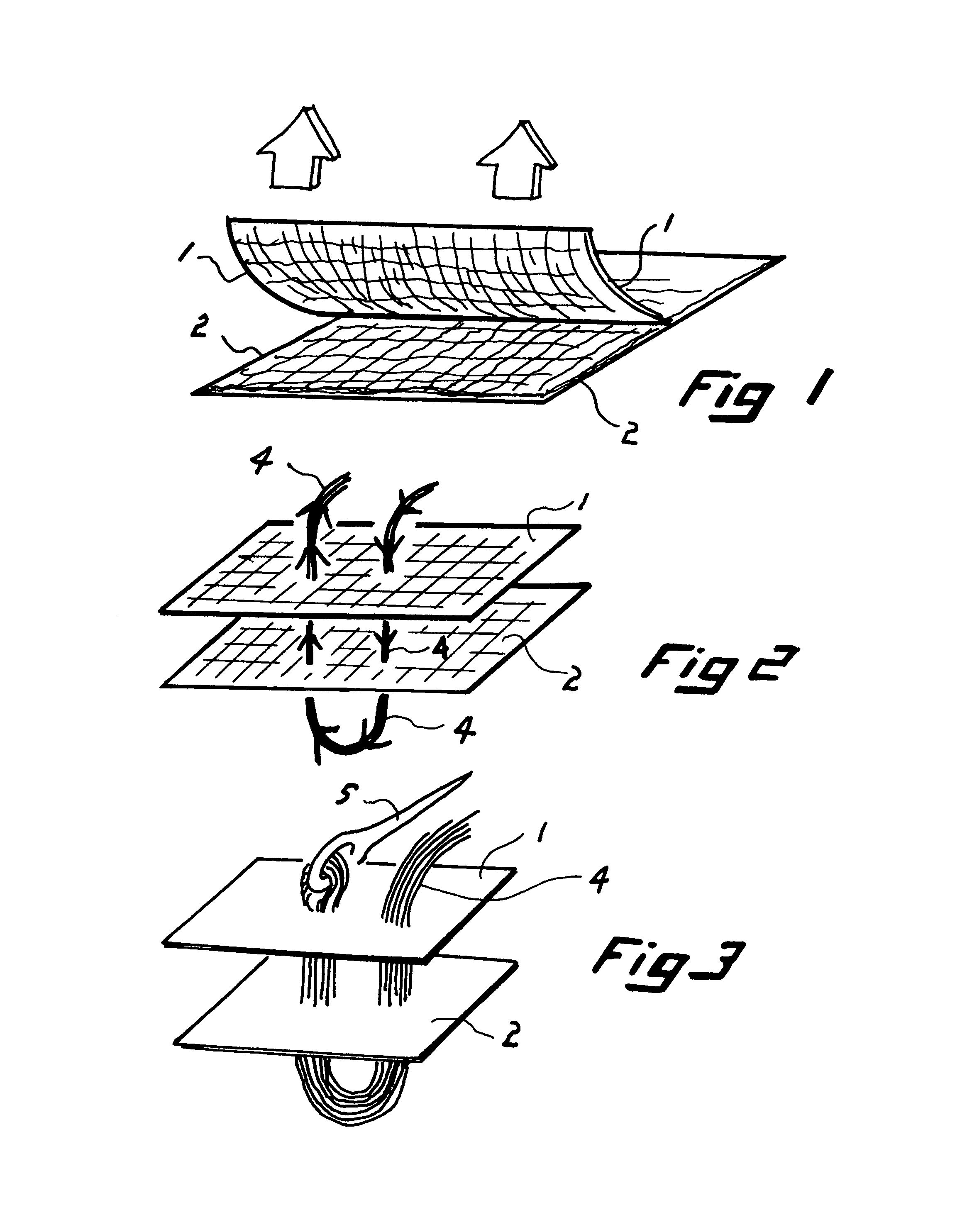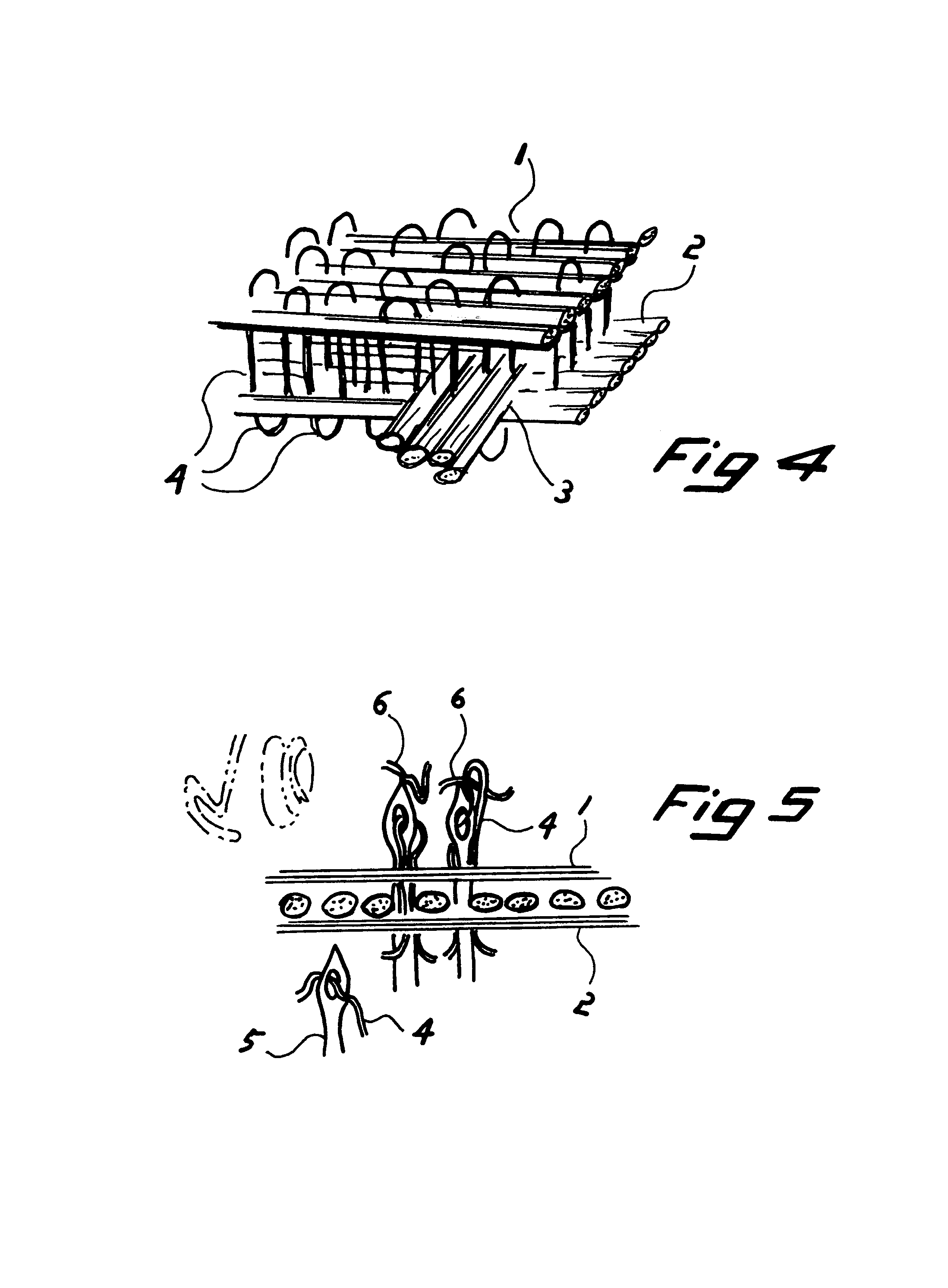Inter/pre-cured layer/pre-cured embroidered composite laminate and method of producing same
a composite laminate and layer technology, applied in the field of pre-curing layer/pre-curing embroidered composite laminate and the field of producing same, can solve the problems of increasing brittleness, affecting the quality of embroidered fabrics, and limiting the process to relatively thin layers, so as to achieve the effect of enhancing the strength of embroidered fabrics between layers
- Summary
- Abstract
- Description
- Claims
- Application Information
AI Technical Summary
Benefits of technology
Problems solved by technology
Method used
Image
Examples
embodiment # 2
ALTERNATIVE EMBODIMENT #2
[0106][FIG. 22] represents the or sandwiching of foreign material such as foam or like core material (i.e. hollow “Hexcell”®, pumice-like “Klegecell”®, etc.) (38) where outside layers (1) and (2) are sewn together and through the foam (38) in order to encapsulate the foam within the laminate. Embroidered fibers (4) hold outer layers (1,2) towards each other in tension
PREFERRED OPERATION
[0107]While practical or symbolic needle (5) in [FIGS. 1,2] pulls fiber bundle / tow (4) through outer layers (1,2) in [FIGS. 1,2], fibers in tow are wetted out or pre-cured (39) in [FIG. 23]. As fiber bundle tow is pulled (embroidered, sewn, tied, needle pointed, and so on), (40), the laminate that is being stitched together (9) is also wet or pre-cured. Said tow (4) is pulled tight enough to make the stitch fast, yet not so tight that it would prevent proper wet-out or impregnation. Tow (4) and laminate (9) are allowed to settle, to be rolled out, to be vacuum-bagged, interfer...
embodiment # 3
ALTERNATIVE EMBODIMENT #3
[0108][FIG. 24] represents a progressively stitched laminate as similar to [FIG. 10] except with base layer (1), progressive layers (10, 11 through 14) being stitched into heterogeneous i.e. metallic substrate (43) through mechanical loops, knobs, dovetail, edge, bowl with a cornice-rim, etc. (43) or through heterogeneous laminated substrate mechanical loop, knob, dovetail, edge, bowl with cornice rim, etc. (44) including looping, wrapping, etc. fibers (45) wherein heterogeneous materials with diverse mechanical, thermo-mechanical, chemical, etc. properties may still remain joined despite being subject to extreme conditions, and extreme chemical, physical, dimensional changes in said heterogeneous materials
embodiment # 4
ALTERNATIVE EMBODIMENT #4
[0109][FIG. 26] represents a thermal heat barrier that could just as easily be chemical, liner, or explosive ceramic armor assemblies. Insulating, refractory, etc. pre-hardened blocks (46) are wet-sewn to wet layer (or pre-cured in pre-fired ceramic), (1) in [FIG. 27], sewn and held there by loops, knobs, etc. in the blocks (43). The blocks can be pre-hardened composite, cast or fabricated heterogeneous material i.e. metallic, and may employ a grouting material (47) if need be. When heat is applied (49), blocks (46) expand [FIG. 28] as shown by graduations (48a) compared to those while cooled (48) in [FIG. 27] and grouted joint (47) is pinched tighter.
PUM
| Property | Measurement | Unit |
|---|---|---|
| thick | aaaaa | aaaaa |
| thick | aaaaa | aaaaa |
| glue strength | aaaaa | aaaaa |
Abstract
Description
Claims
Application Information
 Login to View More
Login to View More - R&D
- Intellectual Property
- Life Sciences
- Materials
- Tech Scout
- Unparalleled Data Quality
- Higher Quality Content
- 60% Fewer Hallucinations
Browse by: Latest US Patents, China's latest patents, Technical Efficacy Thesaurus, Application Domain, Technology Topic, Popular Technical Reports.
© 2025 PatSnap. All rights reserved.Legal|Privacy policy|Modern Slavery Act Transparency Statement|Sitemap|About US| Contact US: help@patsnap.com



